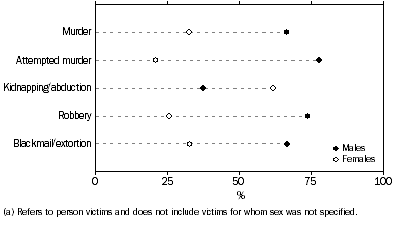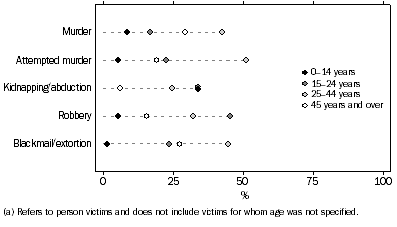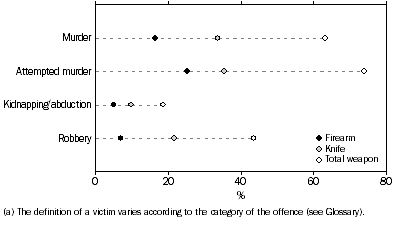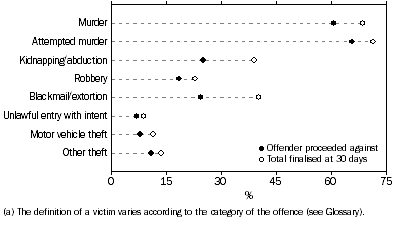SUMMARY OF FINDINGS
INTRODUCTION
This publication presents statistics on incidents of victimisation for a selected range of offences that came to the attention of police and were recorded by them in the period 1 January 2006 to 31 December 2006. Experimental statistics on the Indigenous status of victims of recorded crimes are presented for three states and territories at Appendix 1.
When an incident of crime victimisation occurs, there are a number of ways in which this can be measured and a number of stages where a measurement can be taken, from the time that a person perceives that they have been a victim through to reporting to police and the laying of charges. From among a range of possible ways of measuring crime, there are two major sources of data produced by the ABS that can inform the user about crime victimisation. The first of these is a measure of crimes reported to and recorded by police; and the second is direct reports from members of the public about their experiences of crime as collected in household surveys. Neither of these sources will provide a definitive measure of crime victimisation, but together they provide a more comprehensive picture of victimisation than either measure alone. Both sources have a number of limitations, however, of which users should be aware.
Recorded crime statistics are the result of incidents coming to police attention and a subsequent decision making process carried out by police in accordance with the criminal law. As such they are subject to different legislation, rules of operation and procedures in different jurisdictions. A 'differences in recorded crime' project completed by the ABS in 2005 found that differences between jurisdictions in police recording systems, business rules, procedures and legislation can partly explain differences in recorded crime across states and territories for certain offence types, in addition to changes in the incidence of criminal victimisation. This is particularly so for assault and sexual assault. As a result, this publication does not present national statistics for these two offence categories although data for states and territories are presented. For further information about differences across jurisdictions refer to paragraphs 20 to 96 of the Explanatory Notes.
However, national level information for these offences, as well as data for a range of other offences, are available from the 2005 ABS National Crime and Safety Survey (NCSS) and the 2005 ABS Personal Safety Survey (PSS). Both the NCSS and PSS are conducted periodically by the ABS and were last conducted in 2005. The NCSS measured people's perceptions of crime in the community and whether or not the crimes were reported to police. Further detailed information about the survey results can be found in Crime and Safety, Australia, 2005 (cat. no. 4509.0). The PSS measured people's experience of violence, harassment or stalking. Further detailed information about the survey results can be found in Personal Safety Survey, Australia, 2005 (cat. no. 4906.0).
Caution should be exercised in making any direct comparisons between recorded crime statistics and data from ABS household surveys due to the different scope and coverage, methods of measurement and sources of error. For more information refer to paragraphs 116 to 118 of the Explanatory Notes.
MEASURING CRIME VICTIMISATION
Depending on the type of offence, a victim in the recorded crime collection can be a person, a premises, an organisation or a motor vehicle. A person reporting a crime with multiple offences in the same incident may be counted multiple times depending on the types of offence. For example, a victim who was robbed and abducted in the same incident would be counted separately as a victim under the offences of robbery and kidnapping/abduction. Conversely, a victim of multiple assaults in the same incident would be counted only once as the offences committed fall within the same offence group. For these reasons, it is not meaningful to aggregate the number of victims across each offence type and produce a 'total number of victims'; it is only meaningful to look at victim counts within each offence category.
For further information about the scope and counting methodology of this collection refer to paragraphs 3 to 10 and 98 to 105 of the Explanatory Notes.
NUMBER OF VICTIMS
Compared to 2005, the number of victims recorded by Australian state and territory police agencies in 2006 decreased for motor vehicle theft and other theft, as well as for attempted murder and kidnapping/abduction (table 1). The offence categories recording the largest declines were attempted murder (down 11%) and motor vehicle theft (down 7%). Conversely, there were increases in the number of victims of blackmail/extortion (up 10%) and murder (up 8%).
VICTIMS, Selected Offences(a), Percentage change in number - 2005 to 2006

VICTIMISATION RATE
In 2006, the Australian victimisation rates for selected personal offence categories were:
- Murder 1.4 victims per 100,000 population
- Attempted murder 1.2 victims per 100,000 population
- Kidnapping/abduction 3.5 victims per 100,000 population
- Robbery 84 victims per 100,000 population
- Blackmail/extortion 2.1 victims per 100,000 population (table 1)
Note: For robbery and blackmail/extortion, a victim can be a person or an organisation.
Selected household crimes continued a declining trend in victimisation; motor vehicle theft (365 victims per 100,000 population) had the lowest rate since national reporting began in 1993. The victimisation rate for other theft was the lowest since national reporting began for that offence in 1995 (2,512 victims per 100,000 population).
SEX AND AGE OF VICTIM
In 2006, more males than females were victims of attempted murder (78% of victims were male), murder (66%), robbery (74%) and blackmail/extortion (66%) (table 2). For kidnapping/abduction, more females were victims than males (62%).
VICTIMS(a), Selected offence categories by sex

Over 40% of victims of murder (119 people) and 52% of attempted murder victims (124 people) were aged 25-44 years. A further 29% (81 people) of murder victims were aged 45 years and over.
In 2006, 34% (247 people) of victims of kidnapping/abduction were aged 0-14 years and a further 34% (246 people) were aged 15-24 years. For persons aged 25-34 years, 15% (108 people) were victims of this offence.
More than 45% (6,674 people) of victims of robbery were aged 15-24 years, followed by those aged 25-34 years at 20% (2,953 people).
People in the age group 25-44 years accounted for 44% (163 people) of the total blackmail/extortion victims during 2006, compared with 24% for those aged 45-64 years (87 people).
VICTIMS(a), Selected offence categories by age group

LOCATION OF OFFENCE
Residential locations were the most likely place of occurrence for murder (66%), attempted murder (61%) and unlawful entry with intent (66%) (table 4). For victims of motor vehicle theft, this offence was most likely to have occurred in a community location (46%), followed by a residential location (34%).
Robbery victims were most likely to be subjected to this offence in a community location (57%). Of the total robbery offences occurring in a community location, nearly four in five occurred on a street/footpath. Half of the victims (50%) of kidnapping/abduction were taken from a community location, and a further 35% taken were from a residential location. Retail locations accounted for the highest proportion (30%) of victims of other theft.
VICTIMS(a), Selected offences occurring at residential, community and other locations

WEAPON USE
In 2006, a weapon was used in 74% of attempted murders, 63% of murders and 44% of robberies (table 5). A knife was the most common type of weapon used in committing these offences. Over one third (34%) of murder victims, 35% of attempted murder victims, 22% of the victims of robbery and 10% of kidnapping/abduction victims were subjected to an offence involving a knife. A firearm was involved in a quarter of the offences (25%) of attempted murder, 16% of murder and 7% of robbery offences.
VICTIMS(a), Weapon used in commission of offence

OUTCOME OF INVESTIGATION
In 2006, 71% of the police investigations into attempted murder and 69% of murder were finalised within 30 days of a victim becoming known to police (table 7).
The lowest proportions of finalisations at 30 days were for victims of unlawful entry with intent (9%), motor vehicle theft (11%) and other theft (14%). However, of the total finalised for these offence types, a high proportion had an offender proceeded against by police: other theft and unlawful entry with intent (both 79%) and motor vehicle theft (69%).
VICTIMS(a), Outcome of investigation at 30 days

The highest proportions of investigations finalised where there was no offender proceeded against were for victims of blackmail/extortion (39%), kidnapping/abduction (36%), motor vehicle theft (31%), unlawful entry with intent and other theft (both 21%).
 Print Page
Print Page
 Print All
Print All